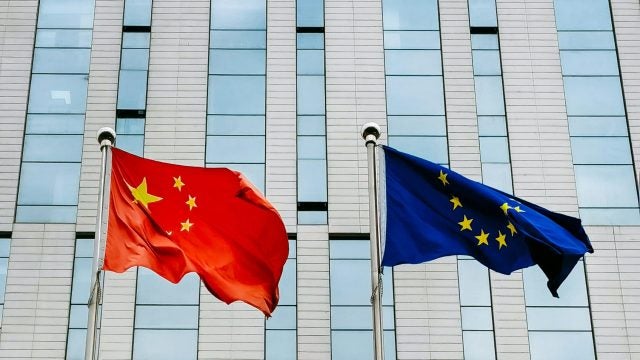Title: US Trade Policy in the Biden Administration: The Challenge of China’s Rise
The Trump administration has left the Biden administration a number of difficult trade policy issues to deal with, but the biggest challenge is likely to be China. The Biden administration will need to find a way forward in the increasingly tense US-China relationship, which covers aspects of trade, as well as foreign policy, security, and human rights issues. This article describes the rise of China as a priority in US trade policy, reviews the current set of US-China trade issues, and makes suggestions for the Biden administration going forward.
The Emergence of China as a Focus of US Trade Policy
Despite a period of rapid growth between 1979 and 1990 under Chinese Vice Premier Deng Xiaoping’s economic reforms, China’s economy was relatively small compared to other industrialized economies at the beginning of the 1990s, and its trade with the United States was limited. At the time, China was not perceived as being as much of a threat as, for example, Japan and Germany were, especially in more advanced sectors.
By the late 1990s and early 2000s, however, China was gaining attention as an economic competitor. To address the concerns of other countries who were wary of the impact of China’s spectacular growth on their own economies, China’s World Trade Organization (WTO) Accession Protocol in 2001 gave these countries special rights to restrict imports from China. At the time, China’s accession to the WTO and integration into the trading system seemed like the big challenge on the horizon. However, the September 11 terrorist attacks, followed by the War on Terror, dominated the foreign policy debate in the United States for years to come. Trade issues related to China were pushed to the background, partly because the United States often needed China’s support, or at least its lack of opposition, to US actions in the War on Terror.
In the ensuing years, Americans grew weary of the War on Terror, and China’s economic power continued to grow. Economists began studying the economic impact of Chinese trade, and their conclusions about job losses and associated effects made headlines. While these impacts were at times exaggerated, they were undoubtedly real and their effects were felt throughout the United States. Partly in response to China’s continued rise, the Obama administration declared a “Pivot to Asia” in foreign policy. More recently, a number of authoritarian developments in China and changes in its foreign policy have brought further negative attention and raised concerns about China’s behavior and role in the world. For some foreign policy hawks, it seems as though China has replaced radical Islam as the “existential threat” of the moment in the United States. For all these reasons, China is likely to be the focus of US trade policy, and foreign policy more generally, for the foreseeable future.
Key Issues in Current US-China Trade Relations
When President-Elect Biden takes office, his administration will have a full plate when it comes to trade with China. The following are some of the main issues that will be on the agenda.
Biden’s trade policy team will first have to decide what to do with the Trump administration’s unilateral Section 301 tariffs, which include 25 percent tariffs on 250 billion dollars of Chinese imports and 7.5 percent tariffs on an additional 120 billion dollars of Chinese goods. These tariffs have resulted in retaliatory tariffs from China on 100 billion dollars of exports. The Biden administration will also have to decide how to handle the “phase one” US-China trade deal negotiated by the Trump administration, which includes purchase commitments, as well as rules on intellectual property protection, agricultural trade barriers, and forced technology transfers. Another question for Biden’s team will be whether to start a phase two of the negotiation, which would cover more difficult issues such as China’s subsidies, state-owned enterprises, and possibly cyber intrusion, or come up with a new plan altogether.
Beyond tariffs and trade agreements, the Trump administration also took many restrictive actions on export controls and foreign investment screening, especially for technology-related products and services. To curb technology transfers to China, restrictions on exports to China were imposed and the review process of the Committee on Foreign Investment in the United States was tightened. These actions led to an uncertain landscape of trade relations and a sharp decline in Chinese investment in the United States. The Biden administration will have to decide whether to continue the restrictive measures or roll them back. There is bipartisan agreement in Congress on the need for strict measures, but there is a degree of flexibility with implementation by the responsible agencies.
The Biden administration will also face a tough decision on what to do with forced labor and other human rights issues in China’s Xinjiang Uyghur Autonomous Region. Recently, the Trump administration announced a number of withhold release orders (WROs) on certain Chinese products that involved state-sponsored forced labor. These were not the first batch of WROs issued to combat China’s forced labor and will likely not be the last. Some Democratic lawmakers have pushed for a broader ban on Chinese goods from the Xinjiang region, which would have a more profound impact on bilateral trade flows.
How to Address Concerns with Chinese Trade Practices
Faced with all of these issues, the Biden administration will have a difficult task in crafting its approach to US-China relations. One crucial component is for the administration to decide what its trade policy priorities will be. While trade with China is the biggest trade issue out there, a range of smaller trade conflicts with other regions has persisted for decades. For example, US agriculture interests have long pressured Europe to relax its regulations that, in the view of US producers, serve as trade barriers for US agricultural exports. The Biden administration can continue to follow the traditional US approach of filing disputes and otherwise badgering the Europeans about this issue. However, cooperation with the European Union on issues related to China will be more difficult if it does so. Thus, a key question for the Biden administration will be: would the United States rather prioritize “food fights” and other disputes with Europe or focus on a joint approach to addressing China’s practices?
In answering this question, the Biden administration should consider that the Trump administration has demonstrated the weakness of a unilateral approach. Its approach to China involved tariff threats, the imposition of tariffs, and then a bilateral deal struck between the United States and China. The results have been unimpressive, although this is not too surprising: a trade deal that emphasizes state-led purchase commitments rather than increased competition through the removal of trade restrictions was of limited value. And a deal without a neutral enforcement mechanism is fundamentally flawed.
With this in mind, the better approach to putting pressure on China is through a two-pronged, coordinated effort by a coalition of countries with market-oriented economies and democratic political systems.
The first prong would be for this coalition to bring WTO complaints against China on a wide range of issues. Although countries have brought numerous cases against China already, with relative success, the complaints generally do not address the full range of China’s trade issues.
People often underestimate the scope of the current WTO rules and the effectiveness of WTO dispute settlement. Even though the Trump administration’s blocking of Appellate Body appointments has undermined the process recently, the WTO’s dispute settlement process has historically been effective. The Biden administration should move forward to restore the Appellate Body and then file more complaints against China. Existing WTO rules on state-owned enterprises, forced technology transfer, intellectual property protection, and export credit subsidies all offer good opportunities for complaints, and at the very least, will bring China to the negotiating table.
The second move should then be for this same coalition to push China to liberalize more. The unilateral approach by the Trump administration has had limited success, but a broader effort could be effective. There is precedent for this approach: China’s WTO accession involved negotiations with all WTO members and yielded the greatest success to date in forcing China to open up. China calculated that the long-term benefits of participating in the multilateral trading system outweighed the short-term economic costs, resulting in it making concessions at the WTO that were more than what it would have been willing to offer otherwise. What is needed is another round of a similar exercise. Along these lines, the Trump administration has already been working with Japan and the European Union on developing new WTO rules on industrial subsidies. Although this particular effort may be unsuccessful due to the concerns of other governments about US, EU, and Japanese subsidies, these three members could work with a wider range of countries to come up with new disciplines that would apply more directly to specific Chinese trade practices, such as forced technology transfers. This could apply enough pressure for China to accept new commitments.
Conclusions
China’s WTO accession was a good start at integrating China into the trading system, but it is time now to finish the job. In doing so, we need to learn from the experience of the past twenty years under the previous three administrations. Biden’s choice for US Trade Representative bodes well for this effort. He has nominated experienced trade lawyer Katherine Tai, who has litigated cases against China in the WTO and speaks fluent Mandarin, and is therefore well-positioned to develop a strategy for addressing China’s trade practices. At the same time, it is important to note that trade policy cannot be conducted in a vacuum, and broader foreign policy issues are likely to play a prominent role in the debate and may at times even take precedence over trade initiatives. Nevertheless, trade policy has an enormous impact on the US economy and competitiveness, and issues related to China are politically important and sensitive. The Biden administration should not let foreign policy get in the way of crafting a coherent approach to trade relations with China along the lines described above.
. . .
Simon Lester is the Associate Director of Herbert A. Stiefel Center for Trade Policy Studies at Cato Institute and the founder of WorldTradeLaw.net.
Huan Zhu is a Research Associate of the Herbert A. Stiefel Center for Trade Studies at Cato Institute.
Recommended Articles

This article contends that South Africa’s 2025 G20 presidency presents a critical opening to shape governance of critical mineral supply chains, essential for renewable energy, digital economies, and national…

Germany’s economy is being throttled by a more competitive China that has usurped its previous manufacturing dominance in many industries. In response, Germany has doubled down on the China bet…

In 2021, the European Union (EU) attempted to assert itself in the Indo-Pacific arena to increase its geopolitical relevance by releasing an ambitious and multifaceted Indo-Pacific Strategy. However, findings from…